Topical tip: Notes on simple direct coupling adapters for attaching digital cameras to microscopes.
by David Walker, UK
I seem to have acquired a miscellaneous assemblage of simple adaptors for connecting cameras to microscopes, originally for film work but now for digital work—some which work better than others. Many are still current models so offer some thoughts on the relative merits of the designs. These don't include the more complex designs by the microscope makers which may incorporate shutters, relay lenses and parallax eyepieces.
Independent camera support or direct coupling?
If my own enthusiast experiences are typical, in the domestic environment using the direct coupling approach may be preferred, not necessarily because it is the best but because it is the most practical. Unless the external support is very robust, it may make matters worse as more potential degrees of freedom can be introduced to contribute to vibration. Very sturdy supports such as massive copying or enlarger type stands maybe impractical on a domestic table where space
is at a premium. However, in a dedicated hobby room, where tables can be selected and space limitations may not occur, a very fine setup for independent camera support can be possible.
Coupling consumer digicams
Some designs of consumer digicam such as the 'small bore' lens Sony W7 / P200 and Canon Powershot with ca. 3x optical zoom have been found by many users to be suitable for photomicroscopy when held on or close to a high eyepoint eyepiece. With optical zoom the vignetting can usually be removed. Apart from models like the Coolpix 9xx and 4500, they don't usually have filter threads, but as remarked in an earlier article, with care handheld work is often
possible, or a homebrew adaptor may also be devised; back to back Moticam adaptors if available also work well with e.g. a P200.
There are commercial adaptors that make use of the camera's tripod socket and tube clamp, SRB Griturn UK and Brunel Microscopes sell such adaptors of various designs. My own example was a robust looking design recently obtained from a German telescope eBay shop for £17 ('Best Offer' price accepted) and is shown below in use with a Sony P200. It comes with two clamps that suits both the typical OD ca. 25 mm microscope tube and the larger ca. 30 mm stereo tube. I've been impressed to date with its ease of use and rigidity.
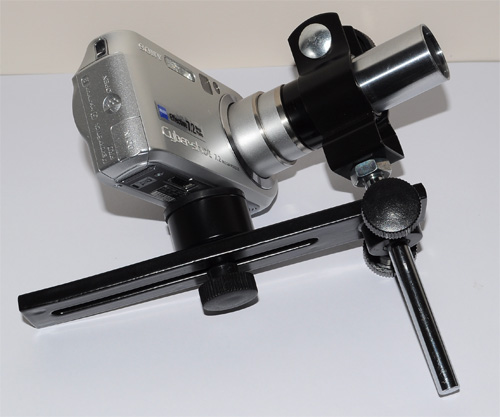
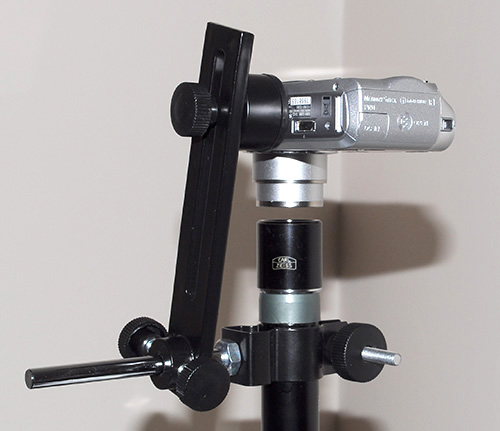
Left: The adaptor being used to support a Sony P200 above a Zeiss Kpl 10x W eyepiece. This eyepiece has a long mount so the clamp can grip the eyepiece and allows the unit to be slipped into a binocular eyepiece tube when required. The camera support and clamps have rubber fittings for secure grip without damage. The combined weight of the camera and clamp is 375g, a weight which shouldn't strain a robust short tube angled eyepiece tube in the author's opinion.
Right: Some eyepieces such as the Zeiss have a high eyepoint and require supporting the camera lens away from eyepiece to optimise the image field. This adaptor allows this to be set readily. Shown here clamped to a vertical tube, where clamp is on tube not eyepiece. (The blue/grey plastic collar shown raises the eyepiece to give a real image for projection.)
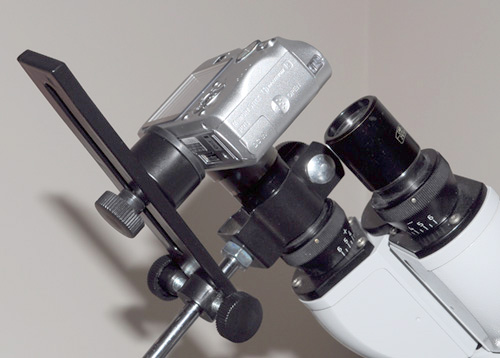
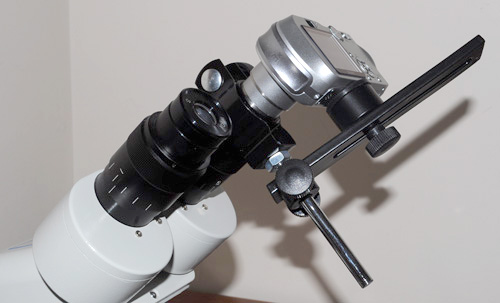
Left: The unit shown left above slipped into the short bino' tube of a Zeiss Photomicroscope III.
Right: Unit with alternative clamp, attached to the 30 mm eyepiece of a Meiji EMZ1 stereo eyepiece. Unlike the Zeiss eyepiece, this eyepiece requires close contact of camera lens and eyepiece to maximise image field. The camera when switched off retracts the lens but comes back to correct position when switched back on. This is my preferred image capture method on my Meiji EMZ1 binocular stereo as have found no ready means to date of coupling my DSLR without severe vignetting. (Independent supports designs for DSLR using an SLR lens as relay have been described by Ted Clarke.)
Digital SLR adaptors
A wide variety of branded and third party adapters to attach 35 mm SLR bodies to a microscope have been made and in principle should be suitable for the smaller APS sensor DSLRs (sensor crop issues aside) or the full frame DSLRs. The author has three third party designs shown below, some more robust than others. They are two piece units, the lower piece clamps onto eyepiece tube with microscope eyepiece sitting inside, the second part attaches to this. They usually have a T2 mount to allow a camera lens mount
of choice to be fitted. The camera maker's designs may be more sophisticated (e.g. with relay lens) and dedicated to their own mount.
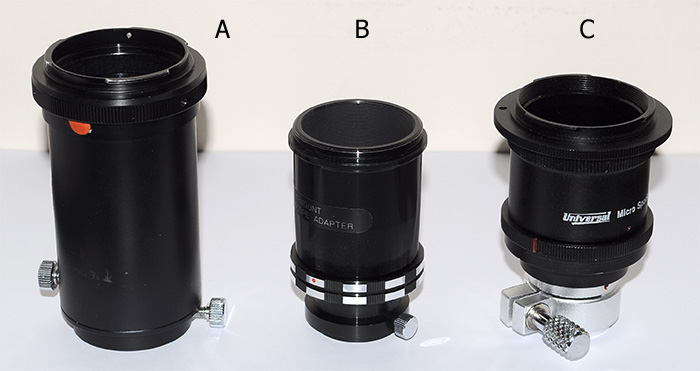
A: This is the design I've used for many years but it is not ideal. Both tube clamp and two piece assembly clamp, use a small knob acting on a C-shaped internal clip. In the author's experiences these clips don't evenly and securely clamp to a good standard of rigidity no matter how tightly clamped. There is invariably a residual flex if camera is rocked once attached to the scope, often in one plane. To minimise this flex it's worth checking the inside of
the adaptor to ensure that the knob is acting on the centre of the C-clip. I set mine so residual reflex is at right angles to the shutter movement.
B: A second design. The lower part also uses a C-clip but poorer than A in rigidity on author's scopes; the upper mount does use in principle a more rigid bayonet fitting but this example doesn't tighten very securely and I don't use this design.
C: A recent purchase off an eBay shop for £12 and widely sold by various outlets, this example with Nikon T2 mount, probably Asian sourced. This is more rigid than A and B as uses a directly acting clamp rather than the indirect method. The upper part uses a bayonet design but has knurled ring to secure it so safer. As received though it was of no use on the author's scopes. The tube clamp fully tightened was loose on the 25 mm tubes. Some time was spent filing the clamp blocks and inserting a
washer below knurled locking nut to clamp firmly. It is now very rigid in use.
Design A uses the typical approx. 5 inch projection distance from eyepiece to film / sensor plane. B and C are somewhat less which can be handy with APS sensors to correct somewhat the crop factor.
None of the above adaptors as received or after modification clamped securely on the Zeiss or LOMO eyepiece tubes, there often seems some variability in exact outer diameter of these tubes. A secure fitting can be achieved by a few circles of eg Sellotape on the tube top. This can also prevent paint damage to the eyepiece tube.
Coupling a camera to an angled tube; is it safe?
If using a vertical mono' tube or trino' head isn't possible so that the weight acts vertically, it is tempting to couple the camera to the angled eyepiece tube—which also presents the camera LCD at a convenient angle for accessing menus and image review (if camera doesn't have an angled screen). But the cameras weight may strain both the tube and its mount, potentially misaligning a head. Some modern DSLR bodies are quite light ca. 500g or less and may be safe on a sturdy shorter tube but
don't think I would try the more professional models which can weigh as much as older film bodies eg close to 1 kg.
A supplementary support eg with a floor or table tripod can be used, and Wan Yu in his June 2010 article shows a tripod successfully in use with an angled student microscope and partially splayed tripod legs. If space is limited it may not be practical and can be prone to knocking. But one alternative I recently stumbled upon, was to use a monopod. I've had one for years in a cupboard, but never really found it useful outdoors but it seems more practical as a camera weight support for photomicrography than a tripod and quite easily setup and removed. A quick release extendable leg section design allows final focus to be set then the monopod is braced and clamped.
|
Right: A LOMO Biolam with a heavy camera body directly coupled to the angled head. Without support the 900g body would put a lot of strain on the finely threaded tube base, but the monopod takes the camera weight while allowing the alignment provided by the coupler. Unlike a tripod, it takes up little space and it's much easier to safely couple and decouple (but still need to be wary of kicking it!). It's not the perfect setup, the potential for lateral vibration is still present, but if used with care to avoid vibration, eg mirror lock, long exposures and/or flash, it can be useful in the absence of a vertical photo setup. A Nikkormat FT3 film body is shown here with adaptor c above (as I was using the digicam!), but DSLRs such as a Nikon D700 DSLR can weigh similar at close to 1 kg. The Biolam is shown here without condenser, as find the concave mirror gives the best even field with the LOMO 3.5x objective with the external LOMO lamps. |
|
Micro four-thirds digital cameras
There are a range of models with this mount / sensor offered by Olympus and Panasonic, from the budget to semi-professional. Essentially the camera uses the same 'four-thirds' sensor that has been established for sometime in the Olympus / Panasonic digital SLR range, except that the mirror is dispensed with, which permits a more compact body and smaller lenses. Because of the small lens mount to sensor distance cf SLRs an 'industry' has rapidly built up supplying adaptors to attach almost
any type of camera lens to the camera body with focus to infinity.
If the microscope has a C-mount trinocular head with a 1 inch relay lens, cheap but well made C-mount to micro four-thirds adapters are available on eBay for typically £14 (Asian sourced, free postage). These allow C mount lenses to be used on the camera with infinity focus, but for the microscopist they should present the camera's sensor plane at near parfocality with the binocular head. The four-thirds sensor is also close to the '1 inch' sensor size so the relay lens should be a good match. These cameras, from handling a family member's Olympus E-P1, are able to set the sensor to 1:1 format, i.e. a better format for an image circle cf the 1.5:1 format of APS and full 35mm frame DSLR sensors.
Note added July 6th 2010: Although these mirrorless cameras no longer have 'mirror slap', the shutter may be still prone to vibration, possibly more so. Thank you to Steve West, a Panasonic GF1 owner, who reports that shutter vibration is still a problem and has found it more severe than for a DSLR he has used. Perhaps the DSLR type shutter in a small compact body can cause vibration issues because of the lighter body. Comments / experiences welcomed.
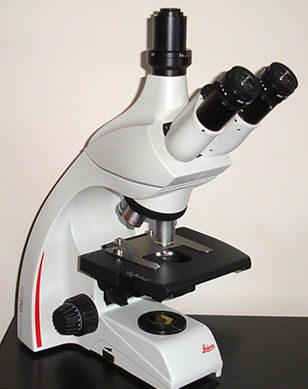
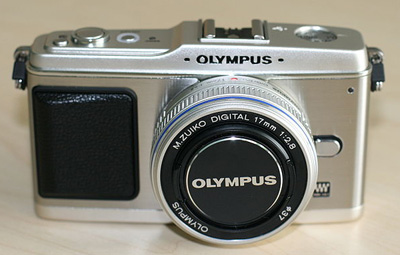
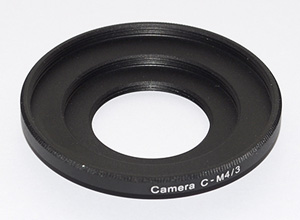
A potential micro four-thirds photomicrography setup. (The author has had access to the above components but no opportunity to assess together.) Users have shared their experiences of similar setups online.
Left: Some trino' heads have C-mount fittings, especially recent models such as this student Leica DM500 with built in 1x relay lens, as it's intended to be used with the often expensive dedicated C-mount microscope cameras.
Middle: A typical micro four-thirds camera, an Olympus Pen E-P1. This has a full sized 4/3rds sensor and removable lens ('micro 4/3' bayonet).
Wikimedia Commons image, used with thanks, attribution: "Source=[http://www.flickr.com/photos/61368956@N00/3634075727/ Olympus E-P1] |Date=June 17, 2009 |Author=[http://www.flickr.com/people/61368956@N00 Julien Min GONG] from Beijing, China |Permission."
Right: A C-mount to micro four-thirds adaptor allowing C-mount lenses to be used at infinity. This should allow near parfocal use on the trino' head.
The 'price' of directly coupling the camera to the microscope is of course the transfer of any camera vibration during exposure to the microscope. The potential for and minimising vibration needs to be assessed and suitable approaches to match the projected image from eyepiece / relay lens to the sensor.
Vibration
The reference books can provide valuable guidelines for the potential causes of and ways to minimise vibration, but it is frequently recommended that a user assesses the potential vibration of their own microscope / camera setup for each objective. With the advent of digital cameras and instant image assessment this is much easier and cheaper than in film days. Lighter microscopes may be more prone; on the author's large Zeiss Photomicroscope III, tests have shown that any shutter speed if
used with the shutter delay feature of a Nikon DSLR can be used with objectives 16x and lower without detectable image quality loss.
A modern digital camera can have a number of features that can aid vibration suppression. Mirror lock, shutter delay, self timer, remote shutter activation, the well documented 'silent mode' on Canon DSLRs which nearly eliminates mechanical vibration. Some of these features can be buried in the menus so worth reading the manual to see what is on offer. Long exposures and flash can also reduce vibration.
Image projection
The resources below discuss the approaches possible; dedicated projection eyepieces to give a real rather than virtual image are available for many makers' optics or some normal eyepieces may be suitable. (The author find a normal Zeiss 10x Kpl W eyepiece gives good quality across the field of a DSLR with APS sensor). Note that extensive refocusing of a normal eyepiece away from its visual image to give a focussed image on the camera can cause image degradation, a better
approach often recommended is to raise the eyepiece on a small collar to create a real image. Spike Walker in his book below discusses this and other options and provides a formula for calculating the collar size required for a given eyepiece mag and projection distance.
Comments to the author David Walker are welcomed.
Selection of photomicrography resources. Some predate digital cameras but the guidelines on camera support, vibration assessment and minimisation are often equally applicable to digital camera setups.
R M Allen, 'Photomicrography', van Nostrand, New York, 1958, (2nd edition).
R P Loveland, 'Photomicrography. A comprehensive Treatise', (2 vols.), Wiley, New York, 1970.
M I Walker, 'Amateur photomicrography', Focal Press, London, 1971.
J G Delly, 'Photography Through the Microscope', Kodak, 1988, (rev. edition).
B Bracegirdle and S Bradbury, 'Modern PhotoMICROgraphy', Bios Science, Oxford, 1995.
D Jackson, 'Better Microscopy, Volume III, Digital Photo-microscopy', Lulu Self Publishing, 2008.
B Matsumoto, 'Practical Digital Photomicrography', Rocky Nook, Santa Barbara, 2010.
